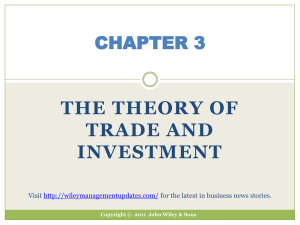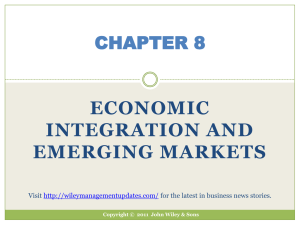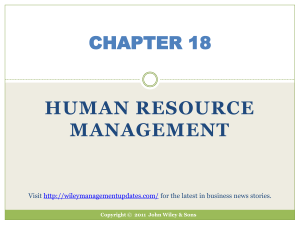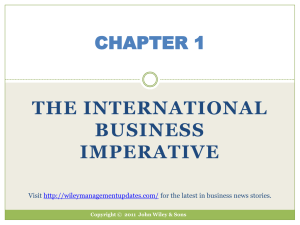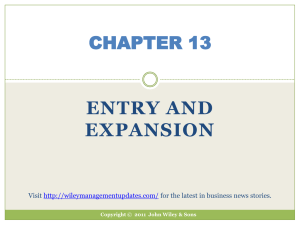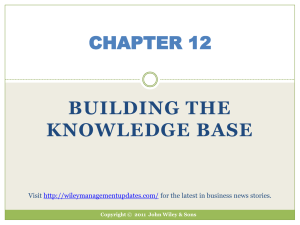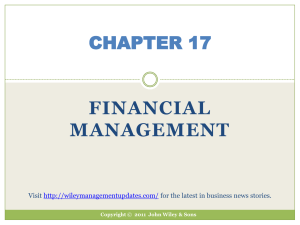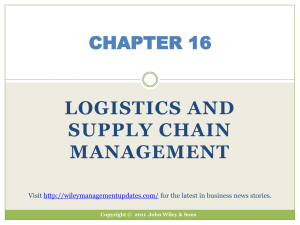Chapter 11
advertisement
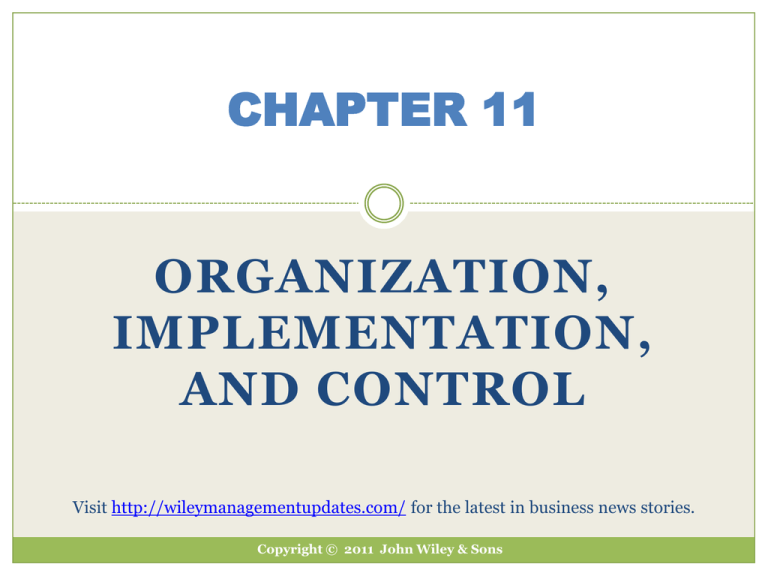
CHAPTER 11 ORGANIZATION, IMPLEMENTATION, AND CONTROL Visit http://wileymanagementupdates.com/ for the latest in business news stories. Copyright © 2011 John Wiley & Sons Chapter 11 Learning Objectives 1. Describe alternative organizational structures for international operations 2. Highlight factors affecting decisions about the structure of international organizations 3. Indicate roles for country organizations in the development of strategy and implementation of programs 4. Outline the need for and challenges of controls in international operations Chapter 11 2 Czinkota: International Business, 8e Functions of an Organization 1. Provide a route and locus of decision making and coordination 2. Provide a system for reporting and communication Chapter 11 3 Czinkota: International Business, 8e Organizational Designs Little or No Formal Organization 1. Domestic operations are responsible for international operations early on Export department may appear as a separate entity or department International division may ultimately be established 2. The International Division Firms recognize the ever-growing importance of the international involvement Coordination between domestic and international operations is necessary Chapter 11 4 Czinkota: International Business, 8e Organizational Designs 3. Global Organizational Structures: Global Product Structure Global Area Structure Global Functional Structure Global Customer Structure Mixed or Hybrid Structure Matrix Structure Chapter 11 5 Czinkota: International Business, 8e Evolution of Organizational Structures First stage: Autonomous subsidiaries reporting directly to top management Second stage: International divisions Third stage: Development of global structures Fourth stage: Some companies opt for a matrix structure to best meet the challenges of global markets Chapter 11 6 Czinkota: International Business, 8e Energy Solutions Announces New Organizational Structure In March 2010, Energy Solutions announced a new organizational structure designed to facilitate the Company's goal of better integrating its unique technologies, assets and expertise in order to design and deliver high value solutions to its customers. Previously, the Company had four operating groups reporting to the Chief Operating Officer. The four groups were international services, federal services, commercial services, and logistics, processing and disposal (LP&D). The Company has reorganized these four groups into three customer-focused groups: the international customer group, the government customer group, and the commercial customer group. Source: Marketwire.com: http://www.marketwire.com/press-release/EnergySolutions-Announces-New-Organizational-Structure-NYSE-ES1140117.htm Czinkota: International Business, 8e Chapter 11 7 Focus on Management: Organizing for Growth Global corporations are adapting their geographic organizational structures to help find revenue growth in emerging markets and scale in developed countries. As new markets emerge, the need to manage increased complexity is necessary. A gateway model has been proposed to reduce the tension between global integration and local responsiveness. Chapter 11 8 Czinkota: International Business, 8e Locus of Decision Making Decentralization – Granting subsidiaries a high degree of autonomy Centralization – Tight controls with strategic decision making at headquarters Coordinated decentralization – Direction of overall corporate strategy by headquarters while granting subsidiaries the freedom to implement strategy within established ranges Chapter 11 9 Czinkota: International Business, 8e Wal-Mart Decentralizes its Supply Chain According to Supply Chain Digest, Wal-Mart recently established a plan to consolidate its global procurement functions and reduce the use of intermediaries in its global sourcing processes. The move would lead to savings of billions of dollars per year. Wal-Mart had been operating in a very decentralized mode, with each of the 15 countries where it operates buying goods from the same suppliers. The company hopes to alter the ratio of its supply chain so that it is buying direct from the manufacturer for 80% of its purchases. Source: Supply Chain Digest: http://www.scdigest.com/ASSETS/ON_TARGET/10-01-06-1.php Chapter 11 10 Czinkota: International Business, 8e Factors Affecting Structure and Decision Making Chapter 11 Degree of Involvement in International Operations The Products Marketed by Firms Size and Importance of the Firm’s Markets Human Resource Capability of the Firm 11 Czinkota: International Business, 8e The Networked Global Organization Glocal – Thinking globally and acting locally Three dimensions of networked global organizations: Develop and communicate a clear corporate vision Effectively manage human resource tools to broaden individual perspectives and develop identification with corporate goals Integrate individual thinking and activities into the broad corporate agenda Chapter 11 12 Czinkota: International Business, 8e The Networked Global Organization Decentralized Federation Model Networked Global Organization HQ HQ Subsidiaries Figure 11.6 Chapter 11 13 Czinkota: International Business, 8e Focus on Entrepreneurship: Centers of Excellence A center of excellence is an organizational unit that incorporates a set of capabilities that have been identified as an important source of value creation. It is intended that these capabilities are leveraged by and/or disseminated to other parts of the firm. Centers of excellence are used as birthplaces and incubators for solutions that can be applied on a worldwide basis. They are in places of strategic importance. Chapter 11 14 Czinkota: International Business, 8e Promoting Global Internal Cooperation Teaching through educational programs and executive development International teams or councils to share best practices Networking Podcasts Webcasts Intranets Virtual teams Cyber-security is an issue of critical importance Chapter 11 15 Czinkota: International Business, 8e The Role of Country Organizations Strategic Leader A highly competent national subsidiary in a strategically critical market Contributor A country with a distinctive competence Implementor In less-developed countries where there is less corporate commitment for market development, but rather for sales Black Hole A low competence country organization in a highly strategic market Chapter 11 16 Czinkota: International Business, 8e The Role of Country Organizations Competence of Local Organization High Strategic Leader Contributor Black Hole Implementer Low High Low Strategic Importance of Local Market Figure 11.7 Chapter 11 17 Czinkota: International Business, 8e Types of Controls Distinction to be made: Variations by design Variations as a result of autonomy Company must use benchmarking and learn and share best practices throughout the firm There must be a device for organizational memory Best practice must be updated and adjusted to new situations Best practice must be legitimized Object of Control must be determined in designing it Control output Control behavior Chapter 11 18 Czinkota: International Business, 8e Bureaucratic/Formalized Control Limited and explicit set of regulations and rules outline the desired levels of performance Elements include: International budget and planning system Functional reporting system Policy manuals to direct functional performance Budgets – Shorter-term guidelines: Allocate funds among subsidiaries Plan and coordinate global production capacity and supplies Evaluate subsidiary performance Communicate information Plans formalized for over one-year horizon Chapter 11 19 Czinkota: International Business, 8e Cultural Control Less formal and are the result of shared beliefs and expectations among the members of an organization Outside the U.S., multinationals emphasize corporate values and culture Requires an extensive socialization process Primary instruments are the careful selection and training of corporate personnel and the institution of self-control Chapter 11 20 Czinkota: International Business, 8e Exercising Controls Different functional areas are subject to different guidelines due to various constraints Degree of control imposed will vary by subsidiary characteristics, including location Management must consider controls on a cost/benefit basis The environment has be to considered The control system must measure only those dimensions over which the organization has actual control Control systems have to be in harmony with local regulations and customs Chapter 11 21 Czinkota: International Business, 8e Toyota Establishes Quality Control Task Force In spring 2010, Toyota Motor Corp. announced that it would establish a global quality-control task force to be headed by the company's president, Akio Toyoda, which will seek to bolster its product. The task force, known as the special Committee for Global Quality, will designate a quality officer from each principal geographical region in which the company operates. The measure was announced at a time when the company was under pressure to spell out what steps it is taking to address design flaws that led to a recall of 8.5 million vehicles worldwide. Source: Marketwatch.com: http://www.marketwatch.com/story/toyota-to-establish-quality-task-force-2010-02-17 Chapter 11 22 Czinkota: International Business, 8e Focus on Ethics: Corporate Acculturation Many of Toyota’s most recent quality problems are partially the result of cultural issues within the company. With 27 different companies and over 320,000 employees around the world, it can be challenging for Toyota and other multinational corporations to organize effectively to maintain a strong corporate culture. In 2009-10, following two separate recalls covering 7.5 million vehicles, Toyota announced it was suspending the sale of eight of its best-selling vehicles. Chapter 11 23 Czinkota: International Business, 8e

